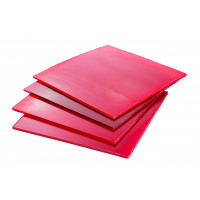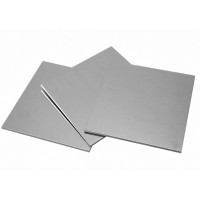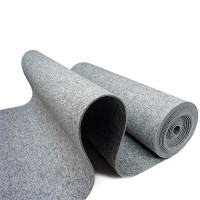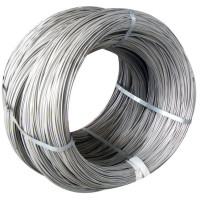Uman polyurethane sheet, rod, polystyrene sheet, PVC sheet, polyamide, polypropylene sheet, fiberglass, polyethylene sheet, geotextile
Polyurethane is an artificial construction material of a new generation, significantly exceeding in its technical characteristics materials based on rubber and rubber, and in certain respects seriously competing with metal. Since polyurethane has excellent physical and chemical properties, it is a highly demanded material in modern industrial production. Polyurethane is a polymer containing in its composition substances polyol and isocyanate, which, in turn, are products of oil synthesis. Polyurethane macromolecules also contain some functional groups (amide, urea), which give the substance the properties of an elastomer. Depending on its composition, polyurethane can have a liquid and solid state of aggregation. Sheet polyurethane is one of the most demanded substances of this type in the industry.
Properties and technical characteristics of polyurethane sheet Polyurethane has a wide range of physical properties that distinguish it from competitors. The elastomer has the following physical characteristics: high strength and tear resistance; high rates of dielectric properties; the material does not absorb moisture, is resistant to atmospheric precipitation; resistant to solvents and oils; resistant to the effects of radioactive radiation; the material has good elasticity at various hardness values, from 40 to 97 Shore units; upon deformation, polyurethane restores its initial geometric characteristics (reverse deformation); sheet polymer withstands pressure up to 100 MPa; polyurethane retains its technical characteristics at operating temperatures up to 120 degrees Celsius. The lower working temperature limit of polyurethane is minus 70 degrees; polyurethane is biologically inert, does not support the growth of mold and fungus, does not rot and can itself act as an anti-corrosion protection. The chemical properties of polyurethane are characterized by high material resistance to some aggressive substances. In particular, the polyurethane may be in contact with solvents and oils. The material is resistant to various petroleum products and can be used in work with fuels and lubricants. It performs well in salty environments and in conditions of high humidity, and also does not collapse and does not change its physical and mechanical properties under the influence of ultraviolet rays. Of the negative properties of the material, one can note its instability to the effects of nitric, phosphoric and formic acids, as well as chemically active media with a high content of chlorine and acetone compounds. The material can be destroyed by prolonged contact with alkalis at high temperatures. When operating polyurethane outside the operating temperature range, there may be cases of changes in its physical and mechanical properties.
Production, cost and dimensions of polyurethane sheet The main part of polyurethane sheet is produced by casting. Both high-temperature injection molding technology and the method of pouring molten raw materials into open matrices without the influence of temperature and pressure are used. Extrusion technology for the production of polyurethane sheets is used less frequently. At present, a wide range of sheet-type polyurethane, both domestic and foreign, is presented on the market of structural materials. Among foreign manufacturers of material, the most popular are companies from the USA, Germany, Italy and, of course, China. Among domestic manufacturers, polyurethane sheets of modifications SKU7L, SKU-PFL100 are most widely used. Grades differ from each other in the following indicators: hardness in Shore units; tear strength; resistance to compression and stretching; the ability to restore shape.
Depending on the brand, thickness, dimensions of the sheet and the manufacturer, the sheet price for polyurethane can vary significantly. The cost of polyurethane sheets of the SKU7L type with a size of 0.5x0.5 m and a thickness of 5 mm starts from 1100 rubles, and the cost of the material of the SKU-PFL100 modification of the same dimensions is 1300 rubles and more. The price of sheet material with similar technical characteristics, but imported, is usually one and a half to two times higher. Each manufacturer of sheet material has its own line of standard dimensions. The thickness of polymer sheets starts from 2 mm and can reach up to 40 mm. The shape of the sheets can be square with dimensions of 400x400 mm, 500x500 mm, 1000x1000 mm, 1200x1200 mm and rectangular with dimensions of 800x1000 mm, 800x1200 mm, 2000x3000 mm. There are sheets of polyurethane up to 8 m long and up to 2.5 m wide. As a rule, when placing an order for the manufacture of material from official representatives of factories, it is possible to produce a batch ofducts with individual dimensions. In this case, the maximum sheet size is limited only by the technical capabilities of the factory equipment.
Application of polyurethane sheet Due to the unique properties and relatively low cost, the use of sheet-type polyurethane has become widespread in many industries. Here are some examples of the use of polyurethane in industry: polyurethane sheets are used as lining elements for bunkers, hoppers, bins, chutes and other units of technological lines for crushing, grinding and transporting mining concentrate. The use of polyurethane lining allows you to save significant funds on the repair, restoration and replacement of rapidly wearing metal surfaces; the material is also used for lining the internal surfaces of capacitive structures of the chemical industry, which are in contact with aggressive media and substances; plates for press dies of forging and stamping shops are made from sheet polyurethane; synthetic polymer plates are used for the production of various sealing elements and bearing surfaces of rollers, rollers, wheels; in the construction industry, polyurethane is used to make individual layers of vibration-resistant floors and coatings, as well as anti-vibration window and door seals; the material is used as anti-slip floor coverings in bathrooms and swimming pools; sheet polymer is used to produce floor mats for passenger compartments and luggage compartments of cars; the material is used for the production of facade systems; Polyurethane is the most suitable material for inclusion in foundation structures for equipment with high dynamic loads. Polyurethane plates serve as shock-absorbing pads for various machines and units, reducing vibration effects on the building structures of buildings and structures. Similar news Properties and applications of two-component polyurethane 22.04.2015 Properties and applications of two-component polyurethane Roof insulation by polyurethane foam spraying 28.04.2015 Roof insulation by polyurethane foam spraying Facing of building facades with thermal panels with clinker tiles 01.05.2015 Facing of building facades with thermal panels with clinker tiles Decor from polyurethane - new opportunities for the interior 10.05.2015 Polyurethane decor - new opportunities for the interior Comments (5) Add comment Your Name Your email Comment Categories Composite materials Polyvinyl chloride Polycarbonate Polypropylene Polystyrene Polyurethane Polyethylene Fluoroplast Recent posts What is HPL plastic and where is it used? Gelcoat - what is it and where is it used? Polyester resin: properties, types, application Polypropylene pipes reinforced with aluminum or fiberglass - which is better? Quartz vinyl tiles: types, installation, pros and cons of coverage
The polyurethane rod or cylinder is the basis for the manufacture of branded parts and sealing products. This product, in terms of its operational features, far exceeds similar materials - rubber, plate and metal products.
The main advantage of cylindrical polyurethane is the resistance to six components:
various acids
solvents
ultraviolet
ozone
water
combustible materials
The rod itself has increased resistance to vibration, deformation and abrasion. It is by and large a dielectric and can be easily processed on a milling and turning machine.
This type of polyurethane can work at temperature ranges from -50°С to +80°С. And only under one condition that a special substance will be added to it, which can exceed the temperature of + 100 ° C.
The first patent for the formulation and method for producing polyurethane was registered by Otto von Bayer and his team of chemists in 1937.
On top of that, it should be said that polyurethane has different colors. And this factor depends on the hardness of the product. Hardness itself is measured on the Shore scale in units. For you, we have prepared a detailed slider on the characteristics of the polyurethane palette.
Advantages of polyurethane over other materials (plastic, rubber, etc.):
Low thermal conductivity;
The possibility of spraying with a layer of up to 12 mm on any type of surface;
Acts as an electrical insulator;
Resistant to the destructive effects of sunlight and flame;
Polyurethane is not covered with ice, is resistant to chemical compounds, salts, but can be destroyed by some concentrated solvents and acids;
Differs in excellent adhesive properties;
Resistant to deformation, reliable and durable;
Protects products or objects from corrosion, mold, microorganisms, decay and other damaging effects;
Does not delaminate, does not crack within the operating temperatures.
Scope of polyurethane
This material is very plastic and elastic, it can be given any shape, densityt and hardness. Polyurethane is able to establish sufficiently strong bonds with various materials, so its use is beneficial. A wide variety of parts are made from it in mechanical engineering, it is widely used in textile, pulp and paper, shoe, chemical and food industries. Polyurethane can also be used to produce building design elements.
Polyurethane is also used for:
Insulation of freezers and refrigerators;
Insulation of buildings and various appliances;
Production of furniture stuffing material;
Mattresses, floor coverings;
Automotive parts;
adhesive mixtures;
Automobile tires and rollers;
Sportswear, soles and heels for shoes;
Panels made of polymer-wood composite materials.
A huge number of products can be obtained using polyurethane rods. The physical properties of this material can fully replace metal, rubber
and even plastic from which a variety of parts are made, designed to repair faulty mechanisms. Composition of polyurethane rods
does not change in such working environments as oils and gasoline. Also, it should be noted the high dielectric properties of the material.
To date, the material has found wide application in various industries, it is especially in demand in the machine tool industry, where its properties are simply necessary.
Solid polyurethane rods can be processed using conventional mechanical or metalworking machines.
The resulting parts can be used as pressure rollers, bushings, guides, rings and other similar products.
It is worth noting that parts made from polyurethane rods usually exceed 20 times the wear of conventional coatings made from rubber.
Like other materials, rods made of polyurethane have a lot of advantages, due to which steels are in demand in many manufacturing industries.
The physical properties of polyurethane rods do not change over a wide temperature range.
Products made of polyurethane rods are particularly strong and durable.
Polyurethane rods can be processed in various ways.
The product is resistant to abrasion and does not change its properties under the influence of aggressive environmental factors.
No questions about this product, be the first and ask your question.





